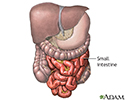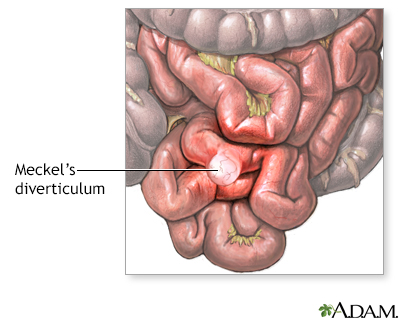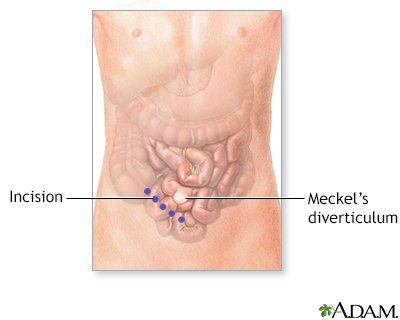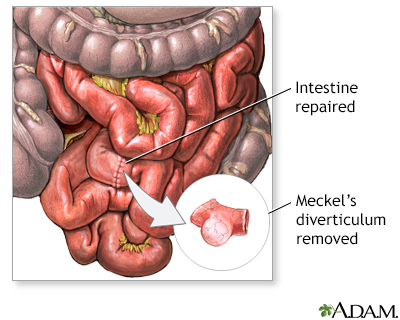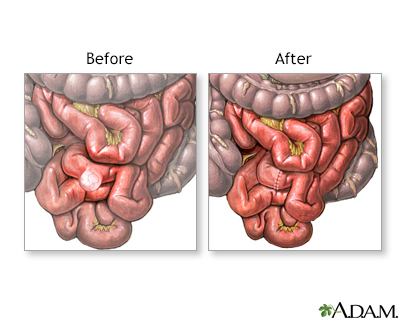Meckel diverticulectomy
Meckel diverticulectomy; Meckel diverticulum - surgery; Meckel diverticulum - repair; GI bleeding - Meckel diverticulectomy; Gastrointestinal bleeding - Meckel diverticulectomyMeckel diverticulectomy is surgery to remove an abnormal pouch of the lining of the small intestine (bowel). This pouch is called a Meckel diverticulum.
Meckel diverticulum
A Meckel diverticulum is a pouch on the wall of the lower part of the small intestine that is present at birth (congenital). The diverticulum may co...

Description
You will receive general anesthesia before surgery. This will make you sleep and unable to feel pain.
General anesthesia
General anesthesia is treatment with certain medicines that puts you into a deep sleep-like state so you do not feel pain during surgery. After you ...
If you have open surgery:
- Your surgeon will make a large surgical cut in your belly to open up the area.
- Your surgeon will look at the small intestine in the area where the pouch or diverticulum is located.
- Your surgeon will remove the diverticulum from the wall of your intestine.
- Your surgeon will close the defect in the intestine with sutures or staples.
- Sometimes, the surgeon may need to remove a small part of your intestine along with the diverticulum. If this is done, the open ends of your intestine will be sewn or stapled back together. This procedure is called an anastomosis.
Anastomosis
An anastomosis is a surgical connection between two structures. It usually means a connection that is created between tubular structures, such as bl...
 ImageRead Article Now Book Mark Article
ImageRead Article Now Book Mark Article
Surgeons can also do this surgery using a laparoscope. The laparoscope is an instrument that looks like a small telescope with a light and a video camera. It is inserted into your belly through a small cut. Video from the camera appears on a monitor in the operating room. This allows the surgeon to view inside your belly during surgery.
In surgery using a laparoscope:
- Three to five small cuts are made in your belly. The camera and other small tools will be inserted through these cuts.
- Your surgeon may also make a cut that is 2 to 3 inches (5 to 7.6 centimeters) long to put a hand through, if needed.
- Your belly will be filled with gas to allow the surgeon to see the area and perform the surgery with more room to work.
- The diverticulum is operated on as described above.
Why the Procedure Is Performed
Treatment is needed to prevent:
- Bleeding
-
Bowel obstruction (a blockage in your intestine)
Bowel obstruction
Intestinal obstruction is a partial or complete blockage of the bowel. The contents of the intestine cannot pass through it.
 ImageRead Article Now Book Mark Article
ImageRead Article Now Book Mark Article - Infection
- Inflammation
The most common symptom of Meckel diverticulum is painless bleeding from the rectum. Your stool may contain fresh blood or look black and tarry.
Risks
Risks for anesthesia and surgery in general are:
- Allergic reactions to medicines or breathing problems
Breathing problems
Breathing difficulty may involve:Difficult breathing Uncomfortable breathingFeeling like you are not getting enough air
 ImageRead Article Now Book Mark Article
ImageRead Article Now Book Mark Article -
Bleeding, blood clots, or infection
Bleeding
Bleeding is the loss of blood. Bleeding may be:Inside the body (internal)Outside the body (external)Bleeding may occur:Inside the body when blood le...
 ImageRead Article Now Book Mark Article
ImageRead Article Now Book Mark ArticleBlood clots
Blood clots are clumps that occur when blood hardens from a liquid to a solid. A blood clot that forms inside one of your veins or arteries is calle...
 ImageRead Article Now Book Mark Article
ImageRead Article Now Book Mark Article
Risks for this surgery are:
- Damage to nearby organs in the body.
- Wound infections or the wound breaks open after surgery.
- Bulging tissue through the surgical cut. This is called an incisional hernia.
- The edges of your intestines that are sewn or stapled together (anastomosis) may come open and leak the contents of the intestine.
- The area where the intestines are sewn together can scar and create blockage of the intestine.
- Blockage of the intestine may occur later from adhesions caused by the surgery.
Adhesions
Adhesions are bands of scar-like tissue that form between two surfaces inside the body and cause them to stick together.
 ImageRead Article Now Book Mark Article
ImageRead Article Now Book Mark Article
Before the Procedure
Tell your surgeon or nurse if:
- You are or could be pregnant
- You are taking any medicines, including medicine, supplements, or herbs you bought without a prescription
During the week before your surgery:
- You may be asked to temporarily stop taking medicines that keep your blood from clotting. These medicines are called blood thinners. This includes over-the-counter medicines and supplements such as aspirin, ibuprofen (Advil, Motrin), naproxen (Aleve, Naprosyn), and vitamin E. Many prescription medicines are also blood thinners.
- Ask your surgeon which medicines you should still take on the day of surgery.
On the day of surgery:
- Follow instructions about when to stop eating and drinking.
- Take the medicines your surgeon told you to take with a small sip of water.
After the Procedure
Many people stay in the hospital for 1 to 7 days depending on how extensive the surgery was. During this time, your surgeon will carefully monitor you.
Treatment may include:
- Pain medicines
- Tube through your nose into your stomach to empty your stomach and relieve nausea and vomiting
You will also be given fluids through a vein (IV) until your surgeon feels you are ready to start drinking or eating. This could be as soon as the day after surgery.
You will need to follow-up with your surgeon in a week or two after surgery.
Outlook (Prognosis)
Many people who have this surgery have a good outcome. But the results of any surgery depend on your overall health. Talk with your surgeon about your expected outcome.
References
Gan T, Evers BM. Small intestine. In: Townsend CM Jr, Beauchamp RD, Evers BM, Mattox KL, eds. Sabiston Textbook of Surgery. 21st ed. St Louis MO: Elsevier; 2022:chap 50.
Greer JB. Small bowel diverticulosis. In: Cameron JL, Cameron AM, eds. Current Surgical Therapy. 14th ed. Philadelphia, PA: Elsevier; 2023:149-152.
Review Date: 9/30/2024
Reviewed By: Jonas DeMuro, MD, Diplomate of the American Board of Surgery with added Qualifications in Surgical Critical Care, Assistant Professor of Surgery, Renaissance School of Medicine, Stony Brook, NY. Review provided by VeriMed Healthcare Network. Also reviewed by David C. Dugdale, MD, Medical Director, Brenda Conaway, Editorial Director, and the A.D.A.M. Editorial team.

